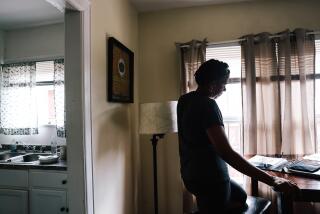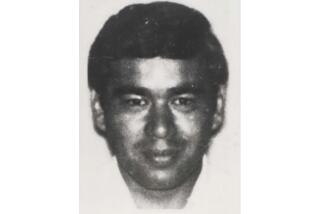Coroner’s long-forgotten evidence unlocks old mysteries
In 2002, two detectives arrived in the musty basement of the Los Angeles County coroner’s office looking for any scrap of evidence that would help them crack a string of killings from three decades ago.
The killer, they suspected, had raped and choked at least three women as they left bars in the San Pedro area. He would come to be known as the Santa Strangler because the first of his victims was found the day after Christmas in 1972.
The detectives had a suspect in mind, a former taxi driver in his 70s with a big, white beard, but they needed biological evidence to prove his guilt. A search of the Los Angeles Police Department’s evidence lockers had proved futile — the evidence was either not preserved well enough to test, or had been thrown out.
Dets. Richard Bengston and Vivian Flores went to the coroner’s office on a whim, without too much hope. They chatted with the evidence clerk, who remembered a dusty, green filing cabinet that had sat untouched for some time.
She took them to the middle of the dim, windowless evidence room and opened a drawer, revealing hundreds of sexual assault slides from the 1970s that had never been logged in the coroner’s database.
“It was incredible, like another ray of hope after hitting a dead end,” Bengston said.
“We knew right there we had a gold mine,” Flores recalled.
At a crime scene, everything on the body and within five feet is gathered by the coroner: clothes, fingernails, bullets and hair. Years ago, once the coroner completed the autopsy, investigating detectives would pick up whatever evidence they thought would be useful. Everything else was left behind and eventually forgotten.
Evidence from cases including hit-and-run deaths, arson and serial killings piled up in the coroner’s basement until freezers were brimming with blood evidence and sexual assault kits, and floor-to-ceiling shelves were overflowing with shrink-wrapped clothing, bullets and gunshot residue samples.
With the advent of DNA and cold-case units, that once-overlooked evidence has become what one detective called a “virtual treasure trove” that has led to breaks in trails long gone cold. The evidence has been used to catch serial killers and rapists. The evidence even led to the arrest of an LAPD detective suspected in the 1986 killing of her ex-boyfriend’s wife because a swab from a bite mark on the victim’s arm was kept in one of the coroner’s freezers.
Bengston could not be more thankful that the original investigators passed up on the slides.
“Had the detectives gone and picked them up they would’ve been destroyed,” he said.
Once detectives learned that mounds of evidence were being held by the coroner, the calls asking for old evidence “went up exponentially,” said Michelle Sandberg, a criminalist who has been supervising the evidence unit since 2009.
“All these cold-case units wanted everything they possibly can from us,” she said. “Typically, they had no idea we were holding so much evidence.”
In the last two years, Sandberg’s two-person unit, plus some volunteers, has been working to enter all the evidence into a database and returning the items to police agencies. Thousands of pieces of evidence have been turned over to cold-case units.
Sexual assault slides, which were created as part of autopsies in the 1970s, have proved particularly valuable.
When coroner’s examiners performing Elizabeth McKeown’s autopsy took swabs from her body and preserved them in slides in 1976, they could at best hope to detect sperm by looking through a microscope. The first use of DNA evidence for forensic profiling was still a decade away.
McKeown was one of a wave of women who fell victim to the Westside Rapist, who preyed on elderly women living alone and left their faces covered with blankets or nightdresses after he had raped and strangled them.
About 30 years after McKeown’s death, police obtained a DNA profile of the rapist from a coroner’s slide. In April, 74-year-old John Floyd Thomas Jr. pleaded guilty to seven of those murders. In six of those cases, Thomas had been linked to the women through evidence preserved on coroner’s slides from the basement cabinet.
Sandberg and her volunteers, mostly master’s students in criminalistics and occasionally some Marines, work in a cheery ground-floor office with the walls painted bright neon orange and green. They have made their way through about two-thirds of the 60,000 cases in their trove, each with three or four pieces of evidence. Case after case sent them on a convoluted search, looking up microfilm or microfiche and deciphering cryptic handwriting on yellowing evidence logs.
Seeing the value of this evidence, the LAPD has assigned a detective to work at the coroner’s evidence section full-time. At the Los Angeles County Sheriff’s Department, cold-case Det. Paul Mondry, rehired after his retirement, has become what he termed “The patron saint of, ‘What do we do now with this evidence?’ ”
Brown paper bags, manila envelopes and cardboard boxes are arranged on metal racks to be picked up by police from Azusa, Beverly Hills and La Habra. There are white tennis shoes and a gunshot residue kit from a possible homicide in the LAPD’s Rampart Division from 1988, and hair and fingernail kits from a 1980 South Los Angeles hit-and-run.
There are 20 years of gunshot residue kits and bullets from 1969 to 1990 in neat cardboard boxes. Sexual assault kits are packed in freezers and one horizontal freezer is devoted to malodorous material.
Some of the evidence will be destroyed if the case has already been adjudicated, the suspect is in custody or dead, or it turns out not to be a homicide. Some will remain on another set of shelves until new technology makes them relevant.
A few pieces of evidence will mete out long-overdue justice, as in the killing of Lois Petrie. For two of the Santa Strangler’s suspected victims, the evidence was too damaged to be used. But the DNA on the slides from Petrie’s autopsy matched the saliva that the suspect, Adolph Theodore Laudenberg, left on a coffee cup in 2003.
In 2007, Laudenberg was sentenced life in prison. He was 80.
More to Read
Start your day right
Sign up for Essential California for news, features and recommendations from the L.A. Times and beyond in your inbox six days a week.
You may occasionally receive promotional content from the Los Angeles Times.







